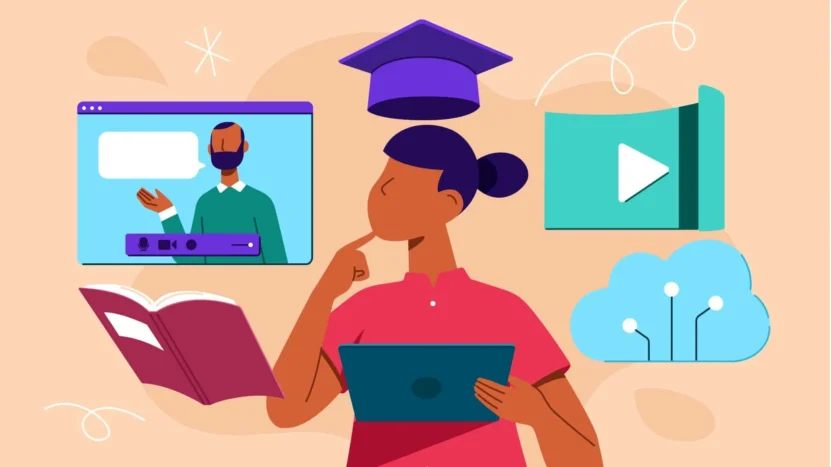
Share Post:
Defined as the process of learning through digital media, eLearning allows students to access materials and participate in courses at their convenience. This approach has gained popularity due to its flexibility and accessibility, making it suitable for various learners, including working professionals and students with diverse schedules.
The COVID-19 pandemic further accelerated the adoption of eLearning, prompting many educational institutions to implement digital solutions to ensure uninterrupted learning. This article examines the definition of eLearning, its benefits, and its impact on education.
Table of Contents
ToggleKey Takeaways
- eLearning is the process of learning through digital media and technologies.
- Students can access course materials anytime and anywhere.
- It includes online courses, degrees, and various digital learning formats.
- eLearning allows for a flexible and self-paced learning experience.
- Traditional teaching methods have evolved to incorporate technology.
- Materials used in eLearning include eBooks, webinars, and multimedia content.
Types of eLearning
eLearning includes various methods and approaches designed to meet different educational needs.
Computer-Managed Learning (CML)

Computer-Managed Learning (CML) uses software to set learning goals and assess student performance. Instructors can create tests, track progress, and provide personalized feedback. CML systems often include features like automated grading and reporting tools, allowing educators to monitor student engagement and achievement effectively.
For example, many universities use platforms like Blackboard or Moodle to implement CML. These systems allow instructors to upload course materials, set deadlines, and track student progress in real time.
Computer-Assisted Instruction (CAI)
Computer-assisted instruction (CAI) combines traditional teaching methods with technology. It includes interactive activities like tutorials, drills, and simulations. Schools and universities frequently use CAI tools such as Khan Academy or Google Classroom.
Synchronous Online Learning
Synchronous online learning involves real-time interaction between students and instructors. Platforms like Zoom and Microsoft Teams facilitate this method, allowing learners to participate in live discussions and collaborative activities.
Asynchronous Online Learning
Asynchronous online learning allows students to access course materials at their convenience. This method uses platforms like Coursera and edX, where learners can watch recorded lectures, complete assignments, and participate in discussions at their own pace.
Blended Learning
Blended learning combines traditional face-to-face instruction with online elements. This approach uses technology to supplement in-person classes, making education more interactive and flexible.
Schools and colleges often use Learning Management Systems (LMS) to facilitate blended learning, allowing students to access resources online while participating in classroom activities.
You can read more about a model like Multimodal Learning here.
Mobile Learning
Mobile learning leverages handheld devices to provide access to educational content anytime, anywhere. Applications like Duolingo and Quizlet allow students to learn on the go, making education more accessible.
Benefits of eLearning
eLearning offers numerous advantages that enhance the educational experience for students and educators alike.
1. Flexibility and Accessibility

Learners can access materials anytime and anywhere, making it easier to balance education with work and personal commitments. Flexibility allows individuals to study at their own pace, accommodating different schedules and lifestyles.
2. Cost-Effectiveness
eLearning reduces costs associated with traditional education. There are no travel expenses or the need for physical materials, such as textbooks. Many resources are available online for free or at a lower cost, making education more affordable.
3. Customized Learning Experience
Personalized learning paths become possible through eLearning. Students can focus on areas they find challenging and revisit materials as needed. This tailored approach improves comprehension and retention.
If you need a challenge, you can take an IQ test to find out how smart you are.
4. Up-to-Date Content
Digital platforms enable rapid updates of course materials. Unlike traditional textbooks, which can become outdated, online resources can reflect the latest information and trends, ensuring learners receive relevant knowledge.
5. Enhanced Engagement
Interactive elements, such as quizzes, videos, and simulations, make learning more engaging. Features encourage active participation, leading to better learning outcomes.
6. Improved Retention Rates
Research indicates that eLearning can increase retention rates compared to traditional methods. The use of multimedia and interactive content reinforces learning and aids memory retention.
7. Environmental Benefits
eLearning has a smaller carbon footprint. Reduced travel and lower resource consumption associated with physical materials contribute to a more sustainable approach to education.
8. Strong Analytics
eLearning platforms often include analytics tools that track student progress. Educators can use this data to identify areas where learners struggle, allowing for timely interventions and support.
9. Scalability
eLearning easily scales to accommodate large numbers of students. Institutions can offer courses to hundreds or thousands of learners without the constraints of physical classrooms.
10. Consistency in Delivery
eLearning ensures that all students receive the same quality of instruction. Educators can provide uniform content, reducing variability in teaching methods and enhancing the overall learning experience.
Drawbacks of eLearning
While eLearning offers many benefits, several challenges must be considered.
1. Lack of Face-to-Face Interaction

One significant drawback is the absence of direct interaction between instructors and students. This lack of personal connection can hinder relationship-building and affect motivation. Many learners thrive on social interaction, which traditional classrooms provide.
2. Dependence on Technology
Online learning relies heavily on technology, creating barriers for those without reliable internet access or adequate devices. Technical issues can disrupt the educational process and cause frustration for both students and instructors.
3. Self-Motivation Required
Success in an online format often depends on a learner’s self-discipline and motivation. Some students may struggle to stay engaged and complete assignments without the structure of a physical classroom.
4. Quality Concerns
Not all online courses maintain the same level of quality. With a vast array of resources available, it can be challenging for learners to identify high-quality programs. Concerns about accreditation and educational standards may also arise.
5. Limited Hands-On Experience
Certain subjects, especially those requiring practical skills, may not translate well to an online format. Fields like science, healthcare, and engineering often need hands-on experiences that virtual learning cannot fully provide.
6. Assessment Challenges
Evaluating student performance in an online environment can be complex. Issues related to academic integrity, such as cheating, may arise, making it difficult to ensure that assessments accurately reflect a learner’s abilities.
7. Learning Curve for Technology
Some students may find it challenging to navigate online platforms and tools. A steep learning curve can hinder the educational process and lead to feelings of frustration and inadequacy.
8. Potential for Isolation
Online education can lead to feelings of isolation for some learners. The lack of a classroom community may result in loneliness, impacting overall well-being and motivation.
9. Varied Learning Styles
Not all students thrive in a virtual learning environment. Different learning styles may not be accommodated effectively, making it difficult for some individuals to grasp complex concepts.
10. Limited Feedback
Instructors may find it challenging to provide timely and personalized feedback in an online setting. Delays in communication can affect a student’s ability to improve and engage with the material effectively.
Conclusion
eLearning has transformed education by offering flexibility, accessibility, and personalized learning experiences. With various methods available, such as Computer-Assisted Instruction and blended learning, students can select the format that best suits their needs.
The benefits are significant, including cost-effectiveness, up-to-date content, and enhanced engagement. However, challenges remain, such as the lack of face-to-face interaction and dependence on technology.
Related Posts:
- Total Number of High Schools in the U.S. (2025 Update)
- 10 Most Trusted eLearning Content Providers in 2025
- Key Benefits of Filing the FAFSA for Students –…
- 9 Key Benefits of Hybrid Learning for Students and Educators
- 10 Benefits of Integrating Technology into Education…
- How AI Is Revolutionizing Education - Benefits & Challenges









